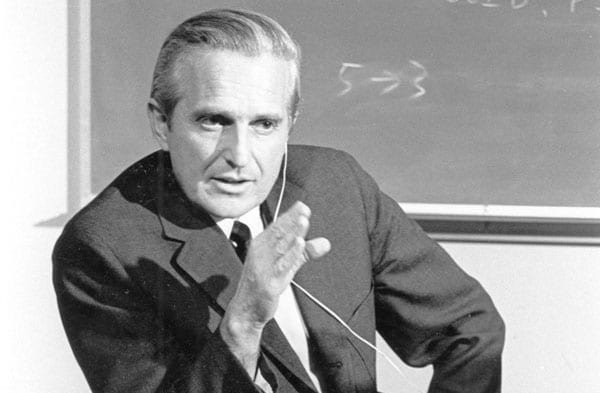Douglas Engelbart and his team held a revolutionary presentation in 1968 that 50 years later in 2018 still raises waves. World first computer mouse, word processing, drag-and-drop functionality, hyperlinks, collaborative editing and much much more. There are many articles about this subject here I would add a few personal notes to this computer world shattering event.
I’ve found a great article about this event, I would extend upon this writing.
All this was started by an 1945 article from Dr. Vannevar Bush. He writes “A library of a million volumes could be compressed into one end of a desk.” “Consider a future device for individual use, which is a sort of mechanized private file and library. It needs a name, and, to coin one at random, “memex” will do. A memex is a device in which an individual stores all his books, records, and communications, and which is mechanized so that it may be consulted with exceeding speed and flexibility. It is an enlarged intimate supplement to his memory.” “It consists of a desk, and while it can presumably be operated from a distance, it is primarily the piece of furniture at which he works. On the top are slanting translucent screens, on which material can be projected for convenient reading. There is a keyboard, and sets of buttons and levers. Otherwise it looks like an ordinary desk.” This article had entranced Doug Engelbart who, in turn, inspired hundreds of students and developers to create the graphical user interface we use today.
To understand, how advanced this demo was, look at the everyday technological objects of that time. On the following image you see a camera, a bakelit disk and a phone used at that time. For example here in Hungary, on the countryside, we were still using manual phone connections, that meant you had to tell someone to connect you with someone else manually, using cables.

Limitations of this demo
While this presentation is praised all over the planet – I was on a “Mother of all Demos” meetup in Paris in December 2018 – very little is spoken about the possible limitations:
- Doug and collegaues needed high level of expertise to operate this system. This includes at least: knowledge about keyboard shortcuts, knowledge of possible statements and invisible options, ability to mentally navigate between statements and files. Most users today do not have and do not want to have such skills.
- I assume there is much more content – mostly technical content – not shown in this video. This might include: hidden links, hidden markers, souce codes, compiled statements, … We see a digestible part, but much remains hidden. ( Maybe more information is included in his later 1969 presentations? )
- The concept of text file is useful, but it is one dimensional. A visual representation of a text file may be 1.5 dimensional, but certainly not two dimensional. Real 2D text editing is still not common today in 2018.
What can we learn from all this?
The computer world in 1968 looked like this:

Computer resources were extremely scarce and expensive. Processors were very slow, memory was a few kilobytes, punched cards were common. Many computers didn’t have a screen output at all. The challenges were:
- Getting resources to develop
- Non existing technologies
- Lack of communication possibilities

I think the world of computing looks like this today. Electronic resources are cheap, IT became mainstream. There is an extreme amount of irrelevant information available and pushed onto users. So the challenges today are:
- Focus, closing out irrelevant information and tech
- Persistently maintaining a clear vision
- Getting advanced products to impatient users
Conclusion
While access to computer resources and development possibilities is much better today, surprisingly few engineers and developers work on Doug Engelbart’s vision or to build upon and extend his vision. Still, we can expect multiple huge advances in everyday user interfaces in our lifetime.


Recent Comments